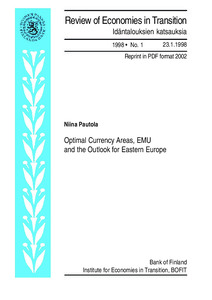Optimal currency areas, EMU and the outlook for Eastern Europe
Pautola, Niina (23.01.1998)
Numero
1/1998Julkaisija
Suomen PankkiBank of Finland
1998
Julkaisun pysyvä osoite on
https://urn.fi/URN:NBN:fi:bof-201408113117Tiivistelmä
The theoretical literature suggests four criteria for judging whether regions should form a currency area: mobility of labour and capital, flexibility of prices and wages, openness to trade and diversity of production.Regions that have relatively closed economies, narrow product ranges, strong price and wage rigidities, and low external mobility of labour and capital should not join monetary union, but should instead retain exchange-rate flexibility. According to Maastricht Treaty, countries wishing to join EMU must fulfil the convergence criteria on interest rate levels, exchange rates, price stability and public debt.Several studies indicate that neither current EU-members nor the Central and Eastern European countries fully satisfy Mundell's criteria for optimal currency area (OCA) or EMU convergence criteria.Therefore, a European monetary union might run more smoothly if limited to a subset of EU members. European Union is less of an optimal currency area than, for example, the US, due to lower factor mobility, more variable real exchange rates and slower response to aggregate shocks.Regarding to convergence criteria, it seems that the majoriy of the EU-countries satisfy the criteria to price stability whereas more efforts are needed where public debt is concerned.In respect of Central and Eastern European countries, the successful conclusion of systematic transformation and market oriented structural reforms is essential before participation in EMU.At present, countries should concentrate on maintaining their commitment to stabilization and on development further modern monetary and fiscal policies. Furthermore, they must complete financial sector reform, and liberalize capital movements.In addition, their central banks have to become fully independent and have price stability as primary objective.Actions should be taken to tackle factors that hinder the efficiency of monetary policy e.g. the volatility of money demand, the poor degree of privatization and competition in the banking sector, the non-existence of a enforcable bankruptcy law, the lack of development of money and securities markets and the problem "bad loans" in the banking sector. Endogineity of OCA criteria argues that suitability of European countries, both Western and Eastern, for EMU cannot be judged on the basis of historical data since the structure of these economies is likely to change in EMU.The more countries integrate with each other, the more highly correlated will be their business cycles. Therefore, if a country, failing the OCA criteria now, goes ahead and joins EMU anyway, its trade linkages and income correlation with other EMU members are likely to rise as a consequence of entry into EMU. Keywords: EMU, OCA, integration, transition, Central and Eastern Europe, enlargement
Julkaisuhuomautus
Uudelleenjulkaistu pdf-muodossa 2002 (Idäntalouksien yksikön sarja)Reprint in PDF format 2002 (Unit for Eastern European Economies series)
